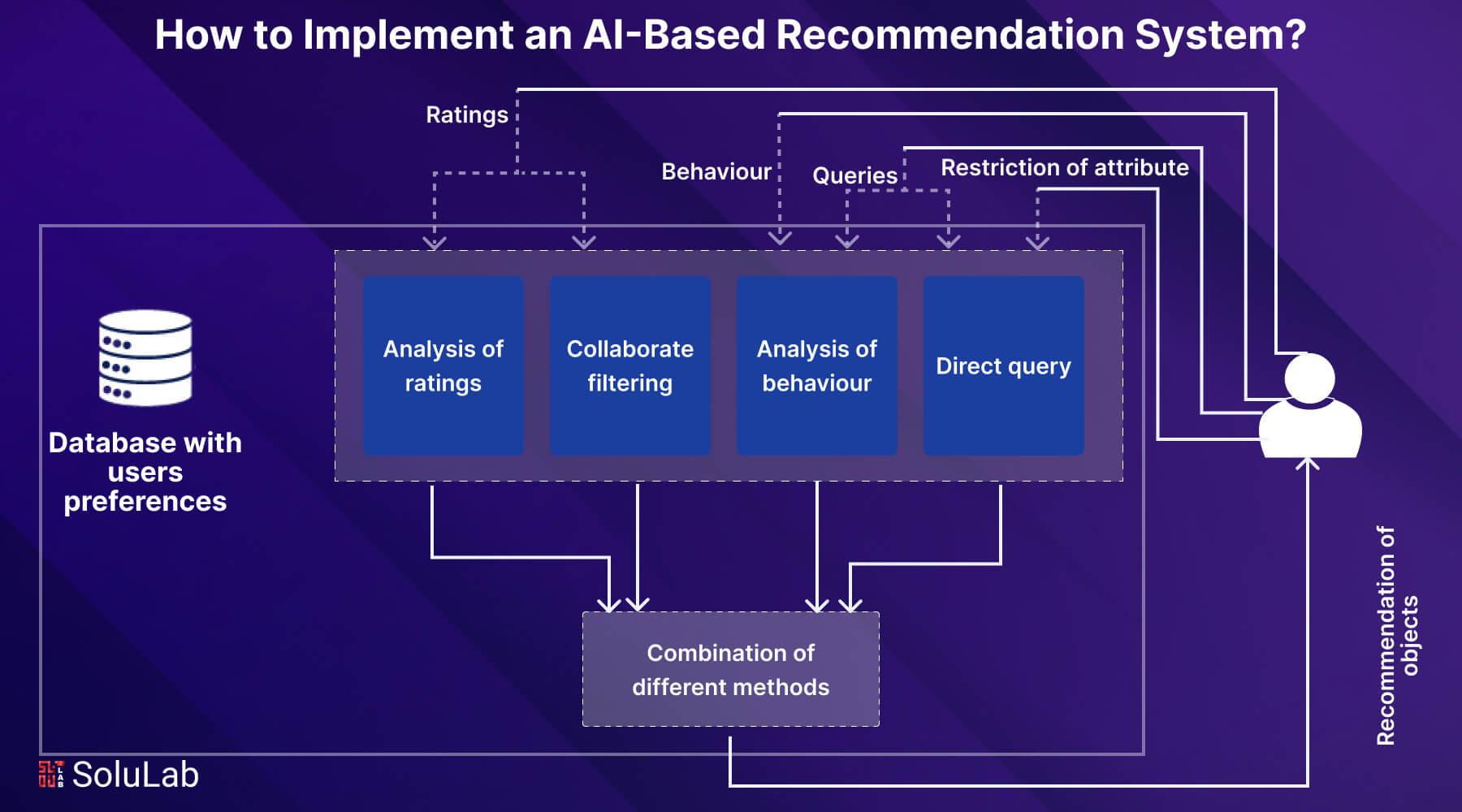How to Implement an AI-Based Recommendation System?

AI-Powered Recommendation Systems have transformed the way businesses interact with users by offering personalized content and product suggestions. These systems are built on machine learning algorithms that analyze vast amounts of data to provide recommendations tailored to individual preferences. Companies aiming to integrate AI into their systems often turn to AI development companies to build robust, efficient recommendation engines. Here’s a step-by-step guide on how to implement an AI-based recommendation system.
1. Define Your Goals for AI-Powered Recommendation Systems
Before diving into the technical aspects, it’s crucial to define the purpose of your AI-powered recommendation system. Different industries have varying needs. For instance:
- E-commerce sites may use recommendation systems to suggest products.
- Streaming platforms may suggest content like movies or music.
- Social media platforms use them to recommend friends, posts, or articles.
By defining clear objectives, it becomes easier to choose the right algorithm and design the system accordingly.
2. Collect and Prepare Data
An essential part of building an AI-powered recommendation system is data. The system relies on historical user behavior data to learn and make predictions. Key data types include:
- User interactions: clicks, purchases, likes, and views.
- Product details: categories, prices, and reviews.
- User profiles: demographics, preferences, and browsing history.
Once data is gathered, it must be cleaned and preprocessed. This involves handling missing values, normalizing data, and categorizing features for effective analysis. Most AI development companies have tools and expertise to handle these tasks efficiently.
3. Choose the Right Algorithm
The choice of algorithms is critical in building successful AI-Powered Recommendation Systems. The most common types include:
Content-Based Filtering
This method recommends items based on the characteristics of the item itself. For example, if a user watches many action movies, the system will suggest other action movies with similar attributes.
Collaborative Filtering
Collaborative filtering focuses on user-user or item-item correlations. By analyzing patterns between similar users or products, the system suggests items that other users with similar interests have liked. There are two types:
- User-based collaborative filtering: Recommends items that users with similar tastes have engaged with.
- Item-based collaborative filtering: Suggests items similar to those the user has already interacted with.
Hybrid Methods
Many modern AI-powered recommendation systems use a combination of both content-based and collaborative filtering to improve accuracy and user satisfaction.
4. Train and Test the Model
Once the data is prepared and an algorithm is selected, the model must be trained. This involves feeding the algorithm historical data so it can learn patterns and make predictions. Tools such as TensorFlow, PyTorch, and scikit-learn are popular for training AI-powered recommendation systems.
After training, testing the model with real-world data is crucial to ensure it performs as expected. Cross-validation and A/B testing can help in assessing the accuracy and efficiency of the recommendation engine. AI development companies often provide insights on optimizing the model for better performance and scalability.
5. Implement Real-Time Recommendations
For an AI-powered recommendation system to provide real value, it needs to work in real-time. Users expect immediate, accurate recommendations based on their latest interactions. Integrating the recommendation engine into your system requires expertise in APIs, server infrastructure, and real-time data processing.
6. Monitor and Optimize the System
Once deployed, the work doesn’t end. Monitoring the performance of your AI-powered recommendation system is essential to ensure continued success. Key metrics to track include:
- Precision: The percentage of relevant recommendations.
- Recall: The system's ability to recommend all relevant items.
- F1-score: A balance between precision and recall.
Regular optimization is required to improve these metrics over time. As user preferences evolve, retraining the model with updated data ensures the system remains accurate and relevant.
7. Consider AI-Powered Chatbots for Enhanced User Interaction
In addition to recommendation systems, many companies also implement AI-powered chatbots to enhance customer experience. These chatbots interact with users, collect data, and can even provide personalized product or content recommendations based on user queries. Integrating chatbots with your recommendation engine can help deliver a more dynamic and interactive experience, giving users real-time suggestions in a conversational format.
8. Partner with the Right AI Development Company
Implementing an AI-powered recommendation system can be complex, requiring expertise in machine learning, data science, and real-time system integration. Partnering with a reputable AI development company can streamline the process and ensure a high-quality solution. These companies bring experience, resources, and knowledge to the table, offering custom solutions tailored to your business needs.
Conclusion
Building an AI-powered recommendation system involves multiple stages, from defining goals and collecting data to selecting algorithms and testing models. By collaborating with an AI development company, businesses can successfully implement a system that not only enhances user engagement but also drives sales and user satisfaction. Additionally, integrating AI-powered chatbots can further enhance the experience, offering personalized suggestions through conversational interactions.
- Art
- Causes
- Crafts
- Dance
- Drinks
- Film
- Fitness
- Food
- Spellen
- Gardening
- Health
- Home
- Literature
- Music
- Networking
- Other
- Party
- Religion
- Shopping
- Sports
- Theater
- Wellness


